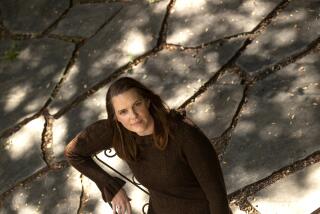Margaret Booth, 104; Film Editor Had 70-Year Career
- Share via
Film editor Margaret Booth, who began her career in silent films with D.W. Griffith and ended it seven decades later editing “The Way We Were” and other films for producer Ray Stark, has died. She was 104.
Booth, who received an Academy Award nomination for “Mutiny on the Bounty” (1935) and an honorary Oscar in 1977, died of complications from a stroke Monday at Century City Hospital in Los Angeles.
“Her collaboration with my company began when she was 70 years old,” Stark said Wednesday, “and her instincts were remarkable even in her later years, when she saved many a film for me.”
Among the many movies Booth edited as a contract “cutter” and later as a full-fledged editor or supervising editor working for various Hollywood studios were “Camille” (1936) with Greta Garbo, “A Yank at Oxford” (1938), “The Red Badge of Courage” (1951), “Fat City” (1973), “The Sunshine Boys” (1975) and “The Goodbye Girl” (1977). Her final movie as an editor was “Annie” (1982).
Born in Los Angeles on Jan. 16, 1898, Booth started in films in 1915 as a “patcher” -- a film joiner -- for Griffith. He gave her a job just out of high school after her brother was killed in an automobile accident and she needed to help out her family. She made $10 a week.
Within a few years, she was working for Louis B. Mayer at the old Mission Road studios, where she learned the editing ropes from director John M. Stahl. She credits Stahl, for whom she edited “The Gay Deceiver” (1926) and “In Old Kentucky” (1927), with telling her “the value of a scene ... when [it] drops or doesn’t drop, and when it sustains.”
“He would tell me why he went to a close-up,” Booth said of the director in a 1976 interview for Films in Focus. “He said, ‘Always play it in the long shot unless you want to punctuate something.’ He told me the different techniques of cutting.”
Booth would work long after hours, practicing on the takes Stahl threw onto the cutting-room floor.
“One day he couldn’t get a sequence the way he wanted it and he said, ‘Did you cut this at all, with the outtakes at night?’ ” She had.
“He said, ‘I like it. I’ll take that.’ And he used my cut. So from then on I started to cut for him.”
From the beginning, she said, she tried to find the rhythm of a movie, to craft a film “like poetry.”
“When I cut silent films, I used to count to get the rhythm,” she told writer Kevin Brownlow in “The Parade’s Gone By,” a 1968 book about silent movies. “If I was cutting a march of soldiers, or anything with a beat to it, and I wanted to change the angle, I would count one-two-three-four-five-six. I made a beat for myself.”
If the film was a comedy, she stepped up the tempo. If it was a musical, she cut on the downbeats. “Otherwise, you get a jarring cut and it throws things off,” she said.
“You should not feel the breaks,” she once said. “It’s like pauses and breaths that you take on the stage. It has its ups and downs and its pace.”
Booth told Brownlow that in her early days cutters would match the print to the negative without edge numbers.
“Sometimes there’d be a tiny pinpoint on the negative, and then you knew you were right,” she said. “But it was very tedious work. Close-ups of Lillian Gish in ‘Orphans of the Storm’ would go on for miles, and they’d be very similar, so we had to help one another.”
Until Booth came along, film editors, many of them women, had little status in the industry.
“You’ve seen clips of these women sitting at rows of Moviolas -- they were called cutters because they cut sometimes with scissors, sometimes with razors,” Cari Beauchamp, author of “Without Lying Down: Frances Marion and the Powerful Women of Early Hollywood,” said Wednesday.
Legendary producer Irving Thalberg was the one who began calling cutters “film editors,” starting with Booth, Beauchamp said.
“He depended on her as much as [he did on] any writer,” Beauchamp said. “The two of them would go to a screening and sit next to each other, making plans for how the re-shoot would be done and how it would be edited.”
The first film Booth edited herself was “The Bridge of San Luis Rey,” released in 1929 -- notable in part because it had a sequence that was partly sound.
The advent of sound made things much more difficult for cutters, who now had to worry about keeping the picture and the sound in sync.
But Booth soon figured it out.
“For three decades, no film left [MGM] without her imprint,” Ally Acker wrote in “Reel Women: Pioneers of the Cinema 1896 to the Present.”
The self-effacing Booth didn’t think of herself as having an editing “style.”
“You have to go by the style of the director,” she once said.
But others told of her commanding presence.
Film editor Dede Allen, who edited “Bonnie and Clyde” (1967) and was nominated for an Oscar for “Wonder Boys” in 2000, said Wednesday that director George Roy Hill did a very funny imitation of Booth.
“She had big eyes, she was very small, very much a lady-lady,” Allen said, “but she had tremendous command.”
Once, when editing a film for Hill, Booth was not happy with something he was doing, Allen said, telling Hill’s story.
“Mr. Hill, are you telling me you want that on a 60-foot screen?” she demanded.
“I guess I don’t, do I?” he replied.
“No, you don’t,” Booth said firmly. In fact, Booth once said, she preferred directors who stayed out of the cutting room entirely.
“Most of them are bad editors,” she told Brownlow.
Roger Mayer (no relation to Louis B. Mayer), now president of Turner Entertainment Co., which owns all MGM films through 1986, said Booth “represented much of what was good about the studio system: the loyalty, the continuity, the knowledge of what went on at a particular studio.”
Booth was at MGM from 1937 to 1968 before working for Ray Stark at Rastar from the mid-1970s until her retirement in 1986.
Mayer said Maggie -- he knew her well and could call her by her nickname, though she preferred most everyone to call her Miss Booth -- was considered difficult by some in the film business, including projectionists.
“They complained about her, and she complained about them,” Mayer said. “Because she was a perfectionist.”
Stark said, “Margaret was a tough, unsentimental editor who read film like others would read a book.”
Booth probably would have agreed with those assessments.
“They liked me because I was fast,” she once said. “And boy, was I tough.”
Booth, who never married, is survived by her cousin, Marie Cetner. A memorial service will be held at 10 a.m. today at the Good Shepherd Catholic Church in Beverly Hills.
More to Read
Only good movies
Get the Indie Focus newsletter, Mark Olsen's weekly guide to the world of cinema.
You may occasionally receive promotional content from the Los Angeles Times.










